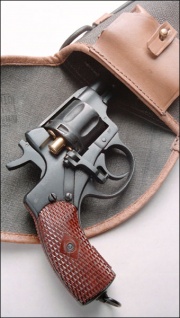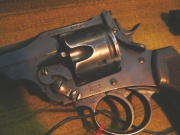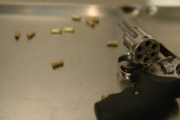Cylinder
In firearms terminology, the Cylinder refers to the cylindrical, rotating part of a revolver containing multiple cartridge chambers. The cylinder revolves around a central axis in the revolver to bring each individual chamber into alignment with the barrel for firing. Each time the gun is cocked, the cylinder indexes by one chamber (in six-shooters, 60°).
Cylinders typically hold six cartridges (hence revolvers sometimes being referred to as "sixguns"), but some small frame revolvers only hold 5 cartridges, due to the smaller overall size of the gun and reduced space availability. The Nagant M1895 revolver has a 7 shot cylinder, the Webley-Fosbery Automatic Revolver has an 8-shot cylinder in .38 caliber, and the LeMat Revolver has a 9 shot cylinder. Several models of .22 rimfire caliber revolvers have cylinders holding 9 or 10 rounds.
As a general rule, cylinders are not designed to be detached from the firearm (except for cleaning). Rapid reloading is instead facilitated by the use of a speedloader or moon clip, although these only work on break-top and swing-out cylinder revolvers, for obvious reasons.

Contents |
Fixed cylinder designs
The first generation of cartridge revolvers were converted caplock designs. In many of these (especially those that were converted long after manufacture), the pin on which the cylinder revolved was removed, and the cylinder taken from the gun for loading. Later models used a loading gate at the rear of the cylinder that allowed one cartridge at a time to be accessed for loading, while a rod under the barrel could be pressed backwards to extract the fired case. Most revolvers using this method of loading are single action revolvers.
Oddly, the loading gate on the original Colt designs (and copied by nearly all single action revolvers since) is on the right side, which may favor left-handed users; with the revolver held in the proper grip for shooting in the left hand, the cartridges can easily be ejected and loaded with the right. This was done because these pistols were intended for use with cavalry, and it was intended that the revolver and the reins would be held in the left hand while the right hand was free to load the cartridges.
Since the cylinder in these revolvers is firmly attached at the front and rear of the frame, and since the frame is typically full thickness all the way around, fixed cylinder revolvers are inherently strong designs. Because of this, many modern large calibre hunting revolvers tend to be based on the fixed cylinder design.
Top break
The next method used for loading and unloading cartridge revolvers was the top break design. In a top break revolver, the frame is hinged at the bottom front of the cylinder. Releasing the lock and pushing the barrel down brings the cylinder up - this exposes the rear of the cylinder for reloading. In most top break revolvers, the act of pivoting the barrel and cylinder operates an extractor that pushes the cartridges in the chambers back far enough that they will fall free, or can be removed easily. Fresh rounds are then placed into the cylinder, either one at a time or all at once with either a speedloader or a moon clip. The barrel and cylinder are then rotated back and locked in place, and the revolver is ready to fire. Since the frame is in two parts, held together by a latch on the top rear of the cylinder, top break revolvers cannot handle high pressure or "magnum"-type rounds. Top break designs are largely extinct in the world of firearms, but are still commonly found in airguns.
One of the most famous "break top" revolvers is the Webley service revolver (and the Enfield revolver, a nearly identical design), used by the British military from 1889-1963. The American outlaw Jesse James used the 19th century Schofield Model 3 break-top revolver, and Tsarist Russia issued the very similar .44 Russian calibre Smith & Wesson No. 3 Revolver from 1870 until 1895
Swing out cylinder
The last and most common method of loading and unloading is the swing out cylinder. The cylinder is mounted on a pivot that is coaxial with the chambers, and the cylinder swings out and down (to the left in most cases, due to right-handed shooters being in the majority). An extractor is fitted, operated by a rod projecting from the front of the cylinder assembly. When pressed, it will push all fired rounds free simultaneously (as in top break models, the travel is designed to not completely extract longer, unfired rounds). The cylinder may then be loaded, singly or again with a speedloader, and closed, where it latches in place. The pivoting part that supports the cylinder is called the crane; it is the weak point of swing-out cylinder designs. Using the method often portrayed in movies and television of flipping the cylinder open and closed with a flick of the wrist will in fact cause the crane to bend, throwing the cylinder out of alignment with the barrel. Lack of alignment between chamber and barrel is a dangerous condition- impeding the bullet's transition from chamber to barrel. This gives rise to higher pressures in the chamber, bullet damage, and the potential for an explosion if the bullet becomes stuck. The shock of firing can also put a great deal of stress on the crane, as in most designs the cylinder is only held closed at one point, the rear of the cylinder. Stronger designs, such as the Ruger Super Redhawk, use a lock in the crane as well as the lock at the rear of the cylinder. This latch provides a more secure bond between cylinder and frame, and allows the use of larger, more powerful cartridges.


